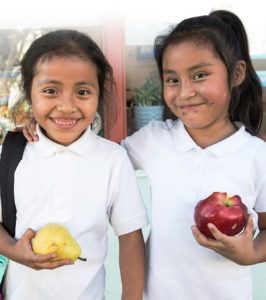Walking into any elementary school at the end of the day is filled with lots of hustle and bustle as kids run to the playground to greet friends and their parents or guardians. That’s certainly the case at Paul Revere Elementary San Francisco’s Bernal Heights neighborhood. Although, there is a difference with this school’s day end and that’s the long tables in the entrance filled with brimming baskets of colorful fresh produce and stables like lentils and rice. That is our Healthy Children’s Pantry.
Since 2004, we started the Healthy Children Pantry Program to make it easier for parents to get healthy food by having pantries at their children’s schools. It was a simple but powerful innovation: By bringing food to busy families in a location they already visit daily, we’ve been able to serve more families than ever before. Now with 58 pantries, parents and guardians throughout San Francisco and Marin can take home healthy groceries once a week when they pick up or drop off their children without having to make any extra stops.
Lilian is one mom who greatly appreciates the Paul Revere pantry. She works full-time cleaning houses and her husband works full-time in construction. With two young children, they struggle to keep up with the rising costs of the city. Finding time to get food is an additional challenge. Some of these time and budget constraints are reduced by having the pantry located at their children’s school. “It’s so convenient. I am so thankful to the Food Bank and their supporters for helping to keep our family healthy,” said Lillian.
Food for Brain Power
Although the Healthy Children’s Pantry has been very successful in helping fight hunger, we don’t stop there. Time after time, principals and teachers tell us the same thing: kids can’t learn when they’re hungry. That’s why we started the Morning Snack Program back in the early 2000s. Through this first-of-its-kind program, 21 high-need public schools throughout San Francisco and Marin receive daily deliveries of healthy snack items such as fresh fruits, whole grain crackers, and string cheese.
Many low-income children don’t eat enough food outside of school to support their growing bodies and minds. Snacks give students a healthy boost mid-morning when they need it most. Teachers report morning snacks give students additional energy to learn and to stay focused during the school day. Over 4,800 kids a day can start school with nutritious food that helps keep hunger at bay and learning in the forefront.
Cousins Estrellia and Luz, students at Paul Revere, are budding math geniuses powered by morning snack. Addition and subtraction are no challenge for this dynamic duo. Every day, between breakfast and lunch, the girls look forward to enjoying a healthy snack. Estrellia loves apples the most while Luz prefers kiwi. They are grateful to the Foodbank for these snacks, “Thank you for the good food. It helps us learn.”





Share